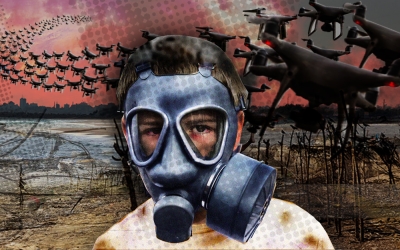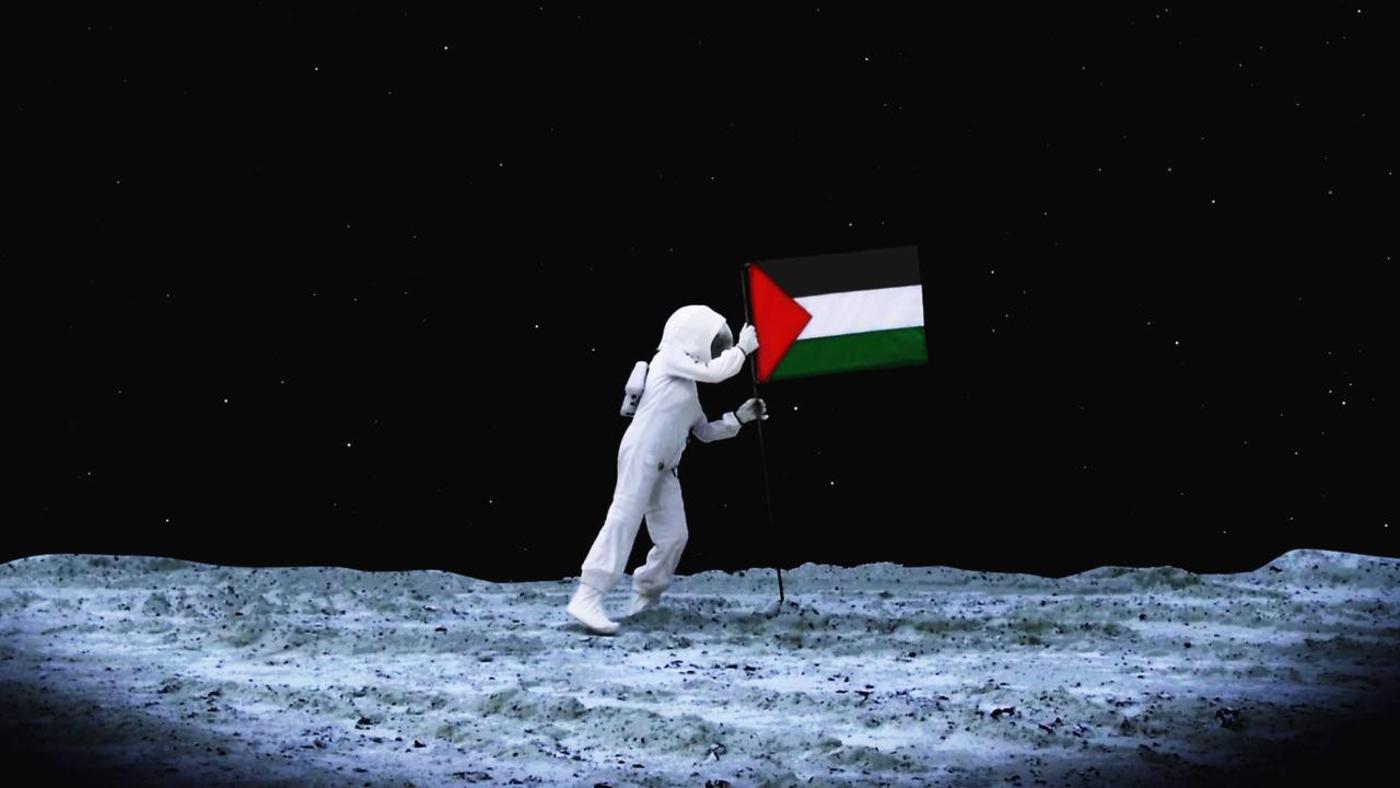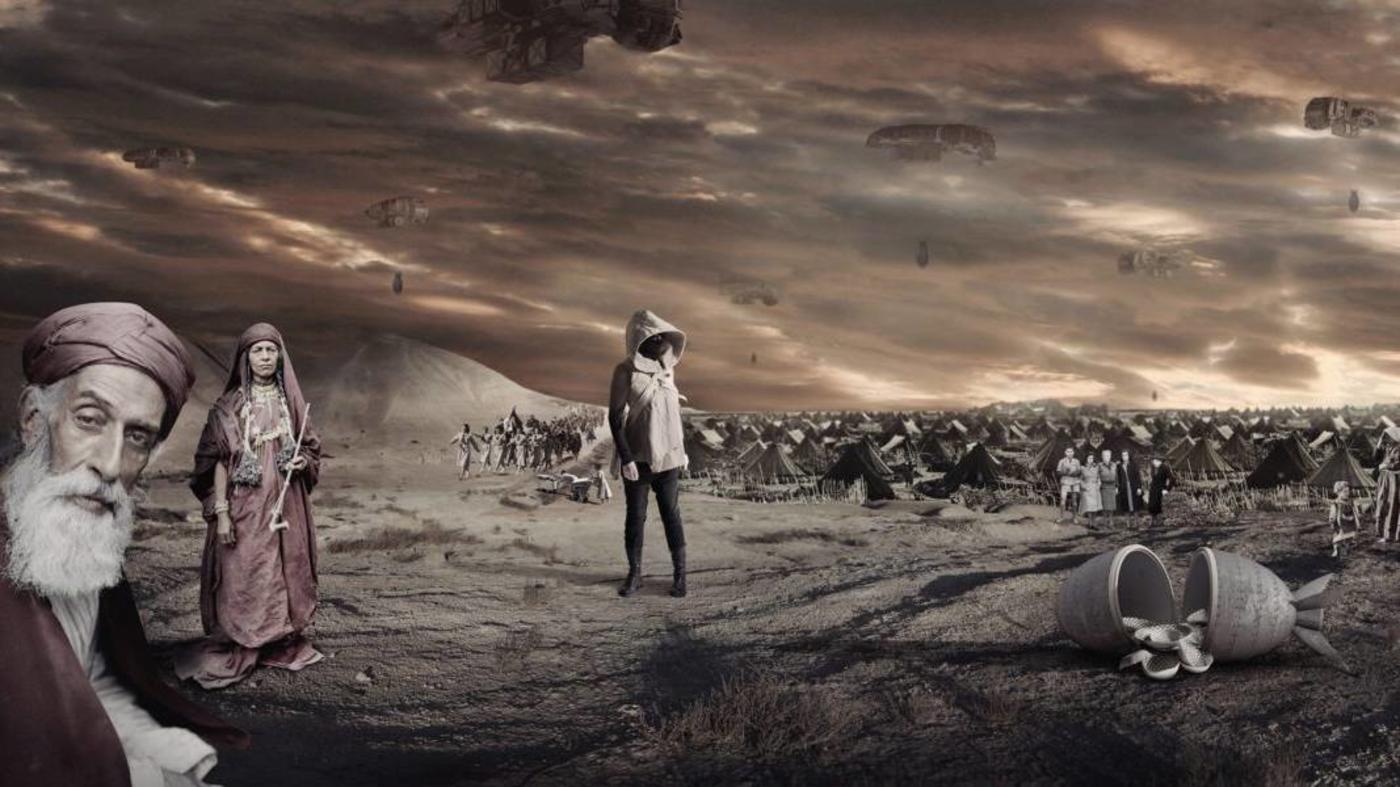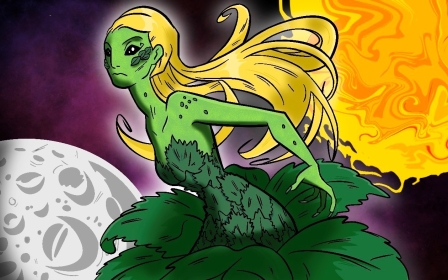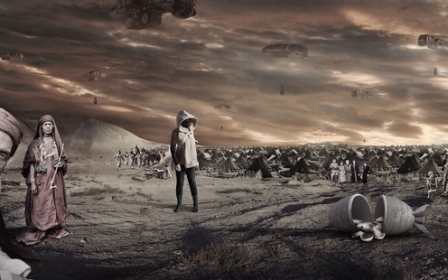Arabfuturism: How Arab artists are building the world of tomorrow

In the northwestern deserts of Saudi Arabia, where the Red Sea meets the Gulf of Aqaba and the Sinai peninsula, a new city is being constructed, which, according to its creators, will be a vision of a "new future".
Neom, the brainchild of Saudi Crown Prince Mohammed bin Salman, is a multilingual contraction of the Greek "neo" (new) and Arabic "mustaqbal" (future).
Among the futuristic landmarks, the area will feature The Line, billed by its backers as the world's first linear mega-city. At 500m high and 170km long, the project is part of Saudi Arabia's Vision 2030, an ambitious plan that aims to diversify the kingdom's economy from oil revenue.
Riyadh plans to use cutting-edge technology, including high-speed trains and artificial intelligence, in such futuristic cities, all powered by renewable energy.
But the project has been mired in controversy, in part for its displacement of tribal groups in the Tabuk province. Critics have been sceptical about the publicity about its green credentials, given it is a carbon-intensive project. There are also concerns about the potential misuse of advanced technologies against future residents of the desert utopia once it finally opens.
New MEE newsletter: Jerusalem Dispatch
Sign up to get the latest insights and analysis on Israel-Palestine, alongside Turkey Unpacked and other MEE newsletters
Some of its promises and hopes may never be realised, but one thing is not in doubt: Neom is the most ambitious attempt yet to imagine an Arab technological future.
It is by no means the first futuristic landscape in the Arab world: such architecture has already characterised Gulf cities such as Dubai, Doha and Abu Dhabi. How are Arab writers and artists responding to this shift from imaginary sci-fi realms into cement-and-glass reality?
In May this year, the first female Arab astronaut arrived at the International Space Station. Both the UAE and Saudi Arabia have plans to launch Arab space missions in the not-so-distant future.
Arabfuturism is a fast-emerging cultural movement among Arab creatives that, at its simplest, re-imagines the world of tomorrow. Moreover, the resulting visions of Arabs and the Arab world are radically different from those circulating in the West.
The phenomenon is also distinct from Gulf Futurism, an aesthetic movement of the 2010s, coined by artists Sophia Al-Maria and Fatima Al Qadiri, which explored oil-driven urban development and an uptake of western technology and consumerism, alongside the local loss of heritage, social inequality and religious conservatism.
Arabfuturism instead borrows heavily from Afrofuturism, which connects Black history to the science and technology of today within a vision of the future
Literature: Apocalypse now
Arab creatives have never been able to access the sizeable Hollywood budgets that helped to create sci-fi epics such as Star Wars or the more recent incarnation of Dune, both of which were inspired by and borrowed heavily from the Arab world.
But one medium where they have been able to share their visions of the future has been literature. Nor is science fiction a new concept in the Arab world, appearing in philosophical treatises like Madina al-Fadila ("Virtuous City"), written by al-Farabi in the 10th century, as well as in stories from The One Thousand and One Nights.
In his 2020 book, Islam, Science Fiction and Extra-Terrestrial Life, Jorg Matthias Detterman argues that the Islamic tradition has generally been supportive of conceptions of extra-terrestrial life and that the Quran repeatedly refers to God as "rabb al-alamin" or the "lord of all worlds".
Evidence cited includes Verse 29 of the Quranic surah (chapter) titled Ash-Shuraa (The Council), which reads: "And among His Signs is the creation of the heavens and the earth, and the living creatures that He has scattered through them."
In more recent years, literature has allowed authors free expression within authoritarian regimes about issues that concern them most about their respective societies.
Utopia (2008) by Egyptian author Ahmed Khaled Tawfik is a sci-fi novel that describes an elite society living within a gated community guarded by former US Marines. Beyond this lies the territory of the Others, described by Tawfik as the "sea of angry poverty outside". The story follows a young couple looking to escape the boredom of utopia by venturing out to kill an Other and bring back a limb as a trophy.
Similar ideas of a broken and stratified society are explored in Basma Abdel Aziz's The Queue (2016), in which the reader is transported to a near future in which all aspects of life have been taken over by a series of orders from a building known as the Gate.
Eventually, it issues a series of edicts that become confusing and difficult to comprehend. Civilians rebel in what the Gate refers to as the "Disgraceful Events" and are met with police brutality.
Abdel Aziz's novel is set in an unnamed city resembling Cairo, and while events take place in the near future, the allusions to present-day politics are all too evident.
Both Tawfik and Abdel Aziz make use of dystopia, a literary device uncommon in the Arab world when Tawfiks novel was first published. It's a largely Egyptian phenomenon, although there are some important examples set in Iraq.
In Frankenstein in Baghdad (2013), Ahmed Saadawi, writes about Iraq as it existed after the US invasion up until the present day.
A Frankenstein-style monster, created from human body parts left over from explosions, is terrorising the city, seeking vengeance for the numerous souls trapped within its composite form.
As such, it serves as a symbol for a country mired in violence and where, amid the chaos, it is impossible to ascertain who is guilty and who is innocent. The novel won the 2014 International Prize for Fiction and was shortlisted for the 2018 Man Booker International Prize.
Translations of Arab sci-fi into English, such as the prize-winning The Second War of the Dog (2018) by Ibrahim Nasrallah, indicate that there is an appetite for reading such works in the West.
Iraq +100: Stories From A Century After the Invasion, edited by Hassan Blasim, is a 2017 collection of short stories where the filmmaker and writer invited 10 authors to imagine what their country look would look like 100 years after the ill-fated American invasion of Iraq (it's part of a series by Comma Press, with other volumes covering Palestine, Egypt and Kurdistan).
Blasim's own entry, The Garden of Babylon, imagines a digital paradise taking over the Middle East, compartmentalising the lives of populations into video-game stories.
Palestinian short fiction writer Basma Ghalayini was inspired by Blasim and invited 12 writers to reflect upon what Palestine might look like in 2048, a century after the establishment of the State of Israel and the mass exodus of an estimated 700,000 Palestinians in what is known as the Nakba ("catastrophe").
In her introduction to Palestine +100: Stories From a Century After the Nakba (2019) she writes that science fiction "uses the future as a blank canvas on which to project concerns that occupy society right now".
Film: A Palestinian on the moon
While Arab film-makers are denied the budgets of their Hollywood counterparts, they are beginning to establish the sci-fi genre within the region.
The likes of Larissa Sansour and Sofia Alaoui may not produce work that, on the surface, has much in common with Arabfuturism, but in many ways their imaginings channel its spirit, with a focus on the flourishing of future technology and themes of dystopia.
Larissa Sansour, a film-maker of Palestinian origin, together with her partner, Soren Lind, has produced a short-film trilogy that explores Palestinian identity and statehood through sci-fi.
In Space Exodus (2009), the first part of the trilogy, Sansour appears as the first Palestinian astronaut to land on the moon and can be seen walking across the lunar surface, planting the Palestinian flag.
In the second part, Nation Estate (2012), a future Palestinian state is imagined as being housed vertically in a skyscraper. The short film follows Sansour as she presents a tongue-in-cheek future solution to a present-day problem.
In the final part, perhaps the most complex, In the Future, They Ate from the Finest Porcelain (2015), the main protagonist, a female resistance leader, enters a future post-apocalyptic world planting fine porcelain plates, decorated with the traditional keffiyeh pattern, in its soil.
The character's hope is that the crockery will be discovered by a future civilisation, thereby legitimising her people's connection to the land.
Sansour's work has been considered politically subversive and has not escaped criticism from pro-Israel groups.
In 2017, when the trilogy was shown at London's Barbican Centre as part of the exhibition Into The Unknown: A Journey Through Science Fiction, a spokesperson from the Board of Deputies of British Jews wrote to the organisers requesting the film be removed.
The Barbican responded by issuing a statement defending its decision to include the work, which remained.
In 2023's Animalia, Moroccan film producer Sofia Alaoui explores troubling facets of society.
The narrative focusses on a pregnant woman from a poor rural Amazigh background who has married into a nouveau-riche family. While her husband is away on business, she is left alone to contend with a mysterious supernatural entity that disrupts society, plunging the country into chaos.
She then embarks on a physical and spiritual journey, questioning her existence as the society to which she was once bound falls apart.
Produced on a limited budget, it premiered at this year's Sundance Film Festival, where it received rave reviews, including from The Hollywood Reporter ("Subverts the genre in compelling ways") and Variety ("Impressively atmospheric and enigmatic feature debut").
Art: Space-age prayers and helmets
Visual artists, too, have used Arabfuturism to reclaim their own futures and assert their own histories and identities. And as with Neom, trends reflect technological advancements within Arab societies
French Moroccan artist Mounir Ayache is an artist in residence at Villa de Medici, Rome, who situates himself within the "unofficial movement of Arabfuturism".
His residency project is based on a manuscript, La Cosmographia de Africa, written by Leo Africanus in 1525, which described Sub-Saharan and Northern Africa and was regarded by Europeans as authoritative until the exploration and colonisation of Africa centuries later.
Lebanese artist Ayman Baalbaki, who is known for his expressive portraits of warriors wearing keffiyehs and gas masks, has produced among other works Helmet (2016), an example of futuristic metal headgear engraved with Arabic calligraphy.
The body of the helmet recalls medieval Islamic armour that was traditionally engraved with prayers of protection for its wearer, only restyled here as if to anticipate the wars of tomorrow.
While not of Arab origin, Saqs Afridi, from Peshawar in Pakistan, describes himself as a sci-fi Sufi artist. Now based in New York, his series of sculptures entitled SpaceMosque featured in the group show "Utopian Imagination" at the Ford Foundation in New York in 2019 and is currently on display at the Kunsthistorisches Museum in Vienna.
Set in a future where human beings have their prayers answered through a mosque-like vessel in outer space, his work imagines a utopian future that is altered by the power of devotion.
Ten years ago, Dana Centre in London held from Sinbad to Sci-Fi, a conference dedicated to Arab imaginings of the future. Among those attending was Ziauddin Sardar, a Pakistani academic and writer, who observed: "I think there are two things you need before you can have science fiction in a society: one is an appreciation of what science is all about, and the second is some awareness of the future."
Across film, literature and visual arts, the creatives at the forefront of the Arabfuturist movement can provide both.
Middle East Eye delivers independent and unrivalled coverage and analysis of the Middle East, North Africa and beyond. To learn more about republishing this content and the associated fees, please fill out this form. More about MEE can be found here.



